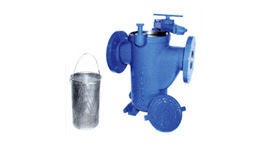 |
| A duplex basket strainer allows continuous process flow when strainer basket requires cleaning. Image courtesy Fabrotech |
Once the maximum particulate diameter has been determined for various portions of the system, a plan can be implemented that provides a properly sized and configured device in place to remove particulates larger than the greatest allowable size. It is conceivable that identifiable parts of a system will have differeing protection requirements, resulting in the use of several or many different filtration elements throughout the system. Filtration units can range from very small inline filter units protecting a single instrument, to large centralized high flow rate units protecting extended portions of the system.
A basket strainer will be an appropriate choice for many applications. Coordination of strainer housing connection size and type, along with design flow rate and pressure drop are in order. The materials of construction for the housing, strainer basket and other wetted parts should be evaluated for suitability with the process media. A final consideration is the holding capacity of the strainer basket itself. Too small a strainer will lead to a service frequency for cleaning that can prove cumbersome for operating personnel.
Regardless of the type of strainer or filter used, a key consideration is whether the system can be temporarily shut down, or the filter bypassed, while replacement or cleaning of the filtration element is accomplished. A basket strainer, one of several types of liquid filtration devices, is available in both simplex and duplex variants. A simplex basket strainer functions as a single inline unit, requiring flow stoppage or bypass when the basket becomes clogged with debris. The changeover time may not be long, but some processes cannot tolerate any downtime. A duplex strainer is comprised of two simplex strainers incorporated into a common housing. An inlet chamber and diverting valve selects which strainer basket will process the liquid flow, while isolating the other. Changes in pressure drop through the device can be used to signal when it is time to switch operation between the strainer sections.
Fluid filtration is an important part of keeping a process in operation, reducing wear and tear on piping system components and equipment. Share your process fluid filtration challenges and requirements of all types with application specialists. Leverage your own process knowledge and experience with their product application expertise to develop an effective solution.


